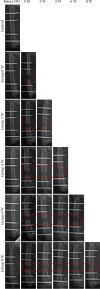The Effect of Distraction Osteogenesis on Peripheral Nerve Regeneration in Rats: A Preliminary Study In Vivo
- PMID: 40226419
- PMCID: PMC11918878
- DOI: 10.1155/2023/8818561
The Effect of Distraction Osteogenesis on Peripheral Nerve Regeneration in Rats: A Preliminary Study In Vivo
Abstract
Distraction osteogenesis (DO) is a widely employed method for the treatment of limb discrepancies and deformity correction. This study aimed at observing the histomorphological and ultrastructural changes of peripheral nerves around the distraction area during DO and investigating the self-repair mechanism of peripheral nerves in a rat DO model. Sixty rats underwent right femoral DO surgery and were randomly separated into six groups: Control (latency, no distraction, n = 10), Group 0-week (after distraction, n = 10), Group 2-week (n = 10), Group 4-week (n = 10), Group 6-week (n = 10), and Group 8-week (n = 10) at consolidation phase. The right femur of rats in Group 0-week, Group 2-week, Group 4-week, Group 6-week, and Group 8-week was subjected to continuous osteogenesis distraction at a rate of 0.5 mm/day for 10 days. Motor nerve conduction velocity (MNCV) of the sciatic nerve, sciatic function index (SFI), histological analyses, and transmission electron microscopy were conducted to evaluate nerve function. The MNCV and SFI of Group 0-week, Group 2-week, Group 4-week, and Group 6-week were significantly lower than the Control (P < 0.05). No statistical differences were found between the Control and Group 8-week in terms of MNCV and SFI (P > 0.05). Injuries to nerve fibres and nodes of Ranvier were observed in the Group 0-week, whereas the nerve fibres returned to the normal arrangement in the Group 8-week and oedema of myelin disappeared, with the continuity of axons and lamellar structure of myelin being restored. Femoral DO in rats with a rate of 0.5 mm/day may cause sciatic neurapraxia, which can be self-repaired after 8 weeks of consolidation. The paraneurium around the sciatic nerve enables it to glide during the distraction phase to reduce the occurrence of injurious changes.
Copyright © 2023 Kai Liu et al.
Conflict of interest statement
The authors declare that they have no conflicts of interest.
Figures





References
Publication types
MeSH terms
LinkOut - more resources
Full Text Sources

